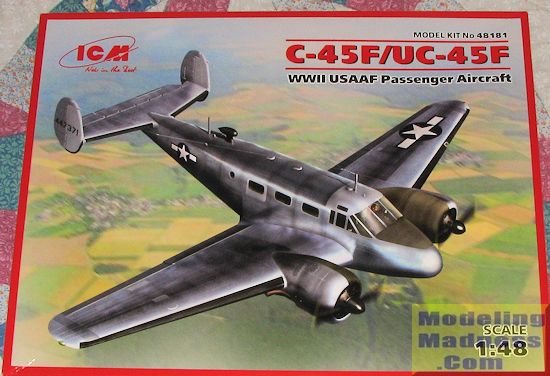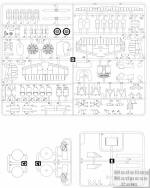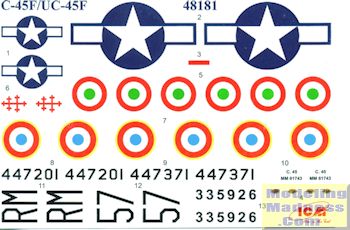
ICM 1/48 C-45F/UC-45F
| KIT #: | 48181 |
| PRICE: | $50.99 SRP |
| DECALS: | Four options |
| REVIEWER: | Scott Van Aken |
| NOTES: | New tool kit |

| HISTORY |
The Beechcraft Model 18 (or "Twin Beech", as it is also known) is a six to 11-seat, twin-engined, low-wing, tailwheel light aircraft manufactured by the Beech Aircraft Corporation of Wichita, Kansas. Continuously produced from 1937 to November 1969, (over 32 years, the world record at the time), over 9,000 were produced, making it one of the world's most widely used light aircraft. Sold worldwide as a civilian executive, utility, cargo aircraft, and passenger airliner on tailwheels, nosewheels, skis or floats, it was also used as a military aircraft.
During and after World War II, over 4,500 Beech 18s saw military service -- as light transport, light bomber (for China), aircrew trainer (for bombing, navigation and gunnery), photo-reconnaisance, and "mother ship" for target drones -- including United States Army Air Forces (USAAF) C-45 Expeditor, AT-7 Navigator, AT-11 Kansan; and United States Navy (USN) UC-45J Navigator, SNB-1 Kansan, and others. In World War II, over 90% of USAAF bombardiers and navigators trained in these aircraft.
In the early postwar era, the Beech 18 was the pre-eminent "business aircraft" and "feeder airliner." Besides carrying passengers, its civilian uses have included aerial spraying, sterile insect release, fish seeding, dry ice cloud seeding, aerial firefighting, air mail delivery, ambulance service, numerous movie productions, skydiving, freight, weapon- and drug-smuggling, engine testbed, skywriting, banner towing, and stunt aircraft. Many are now privately owned, around the world, with over 300 in the U.S. still on the FAA Aircraft Registry in December 2014.
The C-45F, the subject of this kit was a standardized seven seat aircraft based on the C18S. 1,137 of these longer nosed aircraft were eventually ordered. The aircraft was used by the British as the Expeditor II and by the Canadians as the Expeditor III.
| THE KIT |
 Over
the years there have been a number of Beech 18 kits produced in both major
scales. None of them have been particularly accurate and some have been
downright difficult to build. There was much hope that this new kit from ICM
would take care of those issues.
Over
the years there have been a number of Beech 18 kits produced in both major
scales. None of them have been particularly accurate and some have been
downright difficult to build. There was much hope that this new kit from ICM
would take care of those issues.
First let me say that the parts image does not show the two fuselage halves nor the wings, which are a full lower section and a full upper section. This means that the interior is actually the upper wing and all of the cabin and cockpit seats and the control columns are glued onto this piece. The instrument panel and rudder pedal assembly is fit into the fuselage halves before they are joined together. For some reason, ICM molded the ADF football in half on each fuselage half. Why this could not have been an attached part as is provided with 99% of the other kits that have this feature is a mystery. Good luck getting all the seams on this filled.
One must also install all the cockpit side windows and the cabin windows into the fuselage halves prior to assembling these items. Same goes for the interior bulkheads. Seat #7 fits on a ledge at the rear of the right fuselage half. Speaking of seats, these are quite detailed with the cockpit seats alone made up of six parts. There is no belt detail.
Probably the most detailed part of the kit is the landing gear. There are ten construction steps alone that deal with assembling the landing gear, its support structure and the wheel wells. This means a lot of tube frames so break out the fine files for taking care of the mold seams! Conversely, the engines are rather generic and fit onto a firewall. All of these items will fit into the lower wing half. If you don't want to mess with all this, there is a wheels up option.
Before joining the wings, the ailerons need to be installed. The rudders and elevators are molded solid. The fabric representation is simply a number of very long lines on these surfaces. Once the upper and lower wings are joined, then the cabin bits can be attached. I should mention that the engine cowlings are molded in the wing halves, which means a seam at the lip. Why ICM could not have molded the cowling separately to avoid having to deal with this is beyond me. When it comes time to deal with the props and spinner, you'll have some cutting to do. 2.7mm has to be removed from the prop hub and the entire lower half of each spinner has to be cut away as well.
 Instructions
are well drawn with 56 construction steps. There are markings for four planes,
all in overall aluminum. Two are USAAF with one being the uber-boring box art
plane. Another is a plane allegedly at Wright Field in 1944 but why it has
invasion stripes on the lower fuselage is beyond me. The third is a French plane
from the summer of 1944 with very skinny invasion stripes on the upper and lower
wings as well as the fuselage. The tri-color rudders will have to be painted.
The last one is from the Italian Air Force in 1949. For all these options the
inside of the engine cowlings need to be painted black as does the nose
anti-glare panel. All of the de-icing boots will require paint as well, making
for a lot of masking. THe decal sheet itself is fairly well done, though my
experience with ICM decals has been hit or miss. I'll wait for a proper
aftermarket sheet.
Instructions
are well drawn with 56 construction steps. There are markings for four planes,
all in overall aluminum. Two are USAAF with one being the uber-boring box art
plane. Another is a plane allegedly at Wright Field in 1944 but why it has
invasion stripes on the lower fuselage is beyond me. The third is a French plane
from the summer of 1944 with very skinny invasion stripes on the upper and lower
wings as well as the fuselage. The tri-color rudders will have to be painted.
The last one is from the Italian Air Force in 1949. For all these options the
inside of the engine cowlings need to be painted black as does the nose
anti-glare panel. All of the de-icing boots will require paint as well, making
for a lot of masking. THe decal sheet itself is fairly well done, though my
experience with ICM decals has been hit or miss. I'll wait for a proper
aftermarket sheet.
| CONCLUSIONS |
I know that my preview sounds a bit disappointed and you would be right. ICM did several things I just don't understand, but perhaps it is just to be different or the feeling that if a kit isn't difficult in some way, it isn't worth the money. I know that C-45 fans will be glad this one has hit the market. I'm also sure that there will be aftermarket provided to fix whatever folks find that is incorrect. As always, the building will shed more light on things. I'll be anxiously awaiting the first decal sheets before starting on mine.
| REFERENCES |
http://en.wikipedia.org/wiki/Beechcraft_Model_18
January 2015 Thanks to me for picking this one up. If you would like your product reviewed fairly and fairly quickly, please contact the editor or see other details in the
Note to
Contributors.